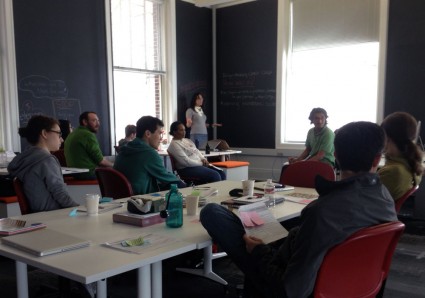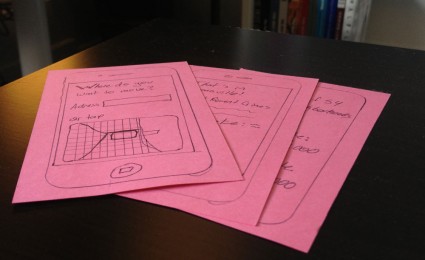On Saturday the Knight Lab hosted its second in a series of three Chicago Crime Hacks, which help hackers explore Chicago’s crime data via the Chicago Tribune’s Crime API. This weekend, in addition to all the usual hack day activities, attendees participated in a unique design thinking exercise.

After a brief bit of instruction from Joe Germuska, Heather Billings and David Eads about how to navigate the API, curious hackers, students, Knight Lab fellows and members from the TribApps team dove into a 90-minute design thinking workshop led by Knight Lab executive director Miranda Mulligan.
Participants paired up to discover and solve individual design challenges centered on crime and crime data. Adapted from Stanford d. School’s design-thinking crash course, the 90-minute problem-to-paper-prototype exercise focused on designing for specific use case and for a specific persona.
Partners began by interviewing each other about their own crime-related concerns in order to design a unique application for each other. For example, while one commuter worried about safety while riding his bike to work, a college student wanted to know how likely he was to lose his phone to theft in specific neighborhoods.
Other proposed applications:
- Showed users when it was safe travel at night by showing them a crime heat map.
- Tacked rising crime levels by neighborhood by comparing historical crime rates with population data.
- Assessed school zone safety with traffic data and offered a crime notification system.
- Analyzed the effects of new policies on overall crime by neighborhood.
- Helped journalists find new stories through different means of crime data visualization, including charts and graphs.
Designers interviewed their partners, proposed solutions, listened to feedback and eventually worked through several iterations of their solutions, before translating their ideas into paper models. The exercise stressed the importance of knowing your user’s wants and needs when designing and ignored the practicality of actually building the technology.

“If your solution involves going to the moon, draw it out,” Miranda encouraged designers.
During lunch (thanks Source!), Chicago Tribune crime reporter Jeremy Gorner spoke about his experience working with Chicago’s Data Portal. And Jeff Kelly Lowenstein, Hoy’s database and investigative editor, detailed how his team, in association with CU-Citizen Access, reported on disparities in arrests in Champaign-Urbana by focusing on jay walking arrests.
Next week, catch the Knight Lab and TribApps team in Pilsen for the third installment of the Chicago Crime Hacks Meetup.
About the author





